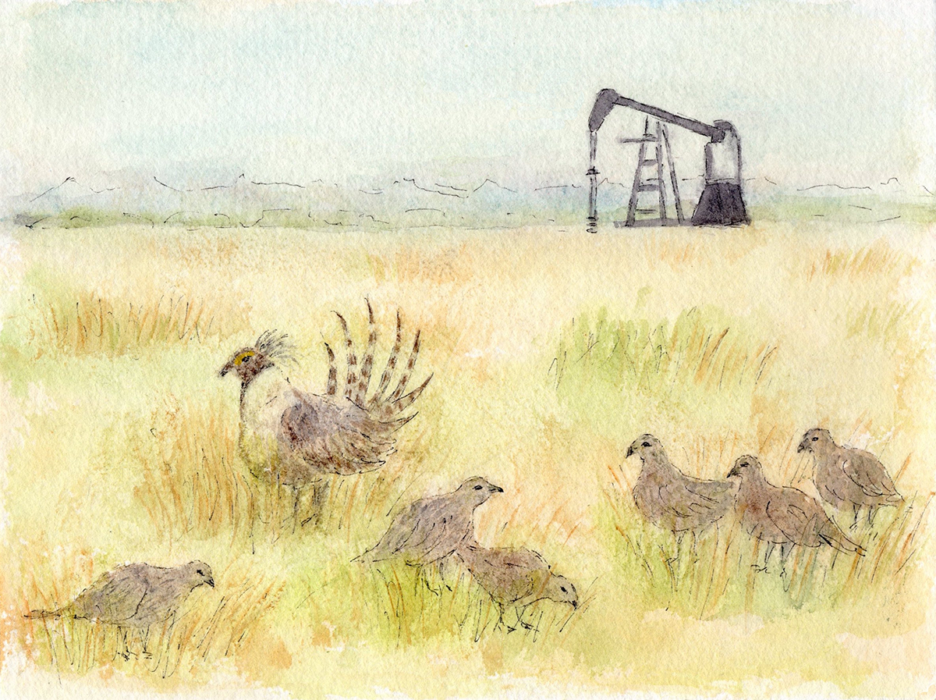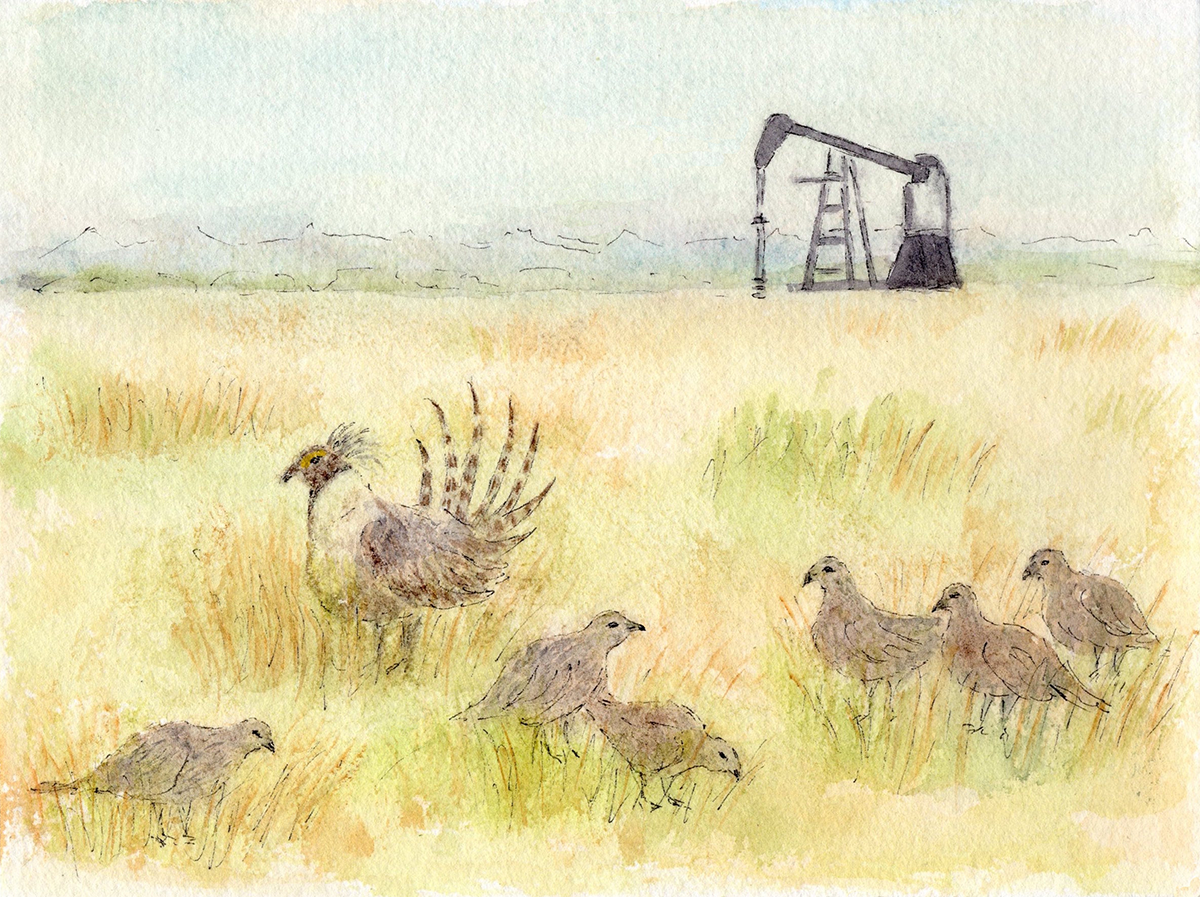
In 2015, a coalition of Western ranchers, sportsmen, energy developers, state leaders, and federal land managers came up with a plan to keep the greater sage-grouse, a vulnerable bird with a fondness for the Western sagebrush steppe, off the endangered species list. The plan hinged, in large part, on the ability to slow down drilling and other activity in designated priority habitat — the areas where sage grouse live and meet each fall to find mates and reproduce.
But that compromise changed in 2017, after President Donald Trump’s administration relaxed protections for the sage-grouse. The result has been a spike in oil and gas leases offered in those very areas the original plan was designed to conserve.
A recent study puts numbers on that jump. The report, commissioned by environmental groups, showed about 2,575 acres were leased in priority habitat per month between late 2015 and early 2017 in seven Western states. From 2017 until March 2019, leases in the same states jumped to 25,002 acres per month. The study comes on the heels of reports showing sage grouse numbers are dropping precipitously and further policy changes that weaken protection for the bird on federal land.
“We have a hell of a fix on our hands,” said Brian Rutledge, vice president of the National Audubon Society and director of the Sagebrush Ecosystem Initiative. “We had a minimal set of rules in place, and they’re being undermined. I’m not giving up, but I’m not buying grouse futures right now.”
Left unchecked, listing the grouse under the Endangered Species Act could follow — a sign that the health of our prairies is in jeopardy, and an action that could drastically affect the energy industry in Western states. But Wyoming, home to both a robust drilling sector and about 40 percent of the nation’s sage-grouse, may show the rest of the region a way forward as federal oversight recedes.
The greater sage-grouse, a bird best known for its odd mating rituals in the middle of prairie, has long been at the center of the energy debate. Its habitat once covered much of the West, from California to the Dakotas and Canada to New Mexico, before a combination of housing, energy development, agriculture, and disease decimated its range.
In 2010, the U.S. Fish and Wildlife Service decided that lack of protection for a shrinking home range qualified the bird for a listing under the Endangered Species Act, but the service declined to formally list it at the time because of higher-priority species. The mere threat of federal protection, though, spurred one of the most collaborative wildlife conservation processes ever in Wyoming. Representatives from energy, agriculture, conservation, government, and sportsmen groups met regularly to find ways to protect some of the bird’s habitat while also allowing varied land uses. Wyoming’s plan did not eliminate leasing and drilling in sage grouse core habitat, but it did prioritize drilling outside of those critical breeding areas and set restrictions on leases within vital areas. Wyoming’s agreement inspired the wide-ranging 2015 federal plan that kept the birds off the endangered species list.
But not everyone was happy, and shortly after taking office in 2017, former Interior Secretary Ryan Zinke spent 60 days reviewing plans and creating amendments that included, most importantly, the provision that land management agencies did not need to prioritize oil and gas leases outside of sage-grouse core habitat areas.
It was with that change that leasing within these areas appeared to spike. That led The Wilderness Society, the National Audubon Society, and the National Wildlife Federation to commission Western EcoSystems Technology, Inc., an environmental consulting company out of Cheyenne, Wyoming, to study the exact numbers.
The report showed the vast majority of increased leasing in habitat areas occurred in Wyoming, from 2,382 acres per month between 2015 and 2017, to 19,071 acres between 2017 and 2019. And drilling could start coming even faster. In March of this year, Zinke’s successor, David Bernhardt, announced that the Bureau of Land Management would make it easier to drill on some 8.3 million acres of grouse habitat; last month, the U.S. Forest Service announced reduced protection on 192,000 acres.
But a spike in leasing, in or outside of core habitat, doesn’t equate to a loss of birds, said Paul Ulrich, director of government and regulatory affairs for Jonah Energy and a member of Wyoming’s Sage Grouse Implementation Team.
First, those leases may never be developed. Ulrich wouldn’t speculate on what percentage of those post-2017 leases may or may not be drilled, but a handful of factors — low energy prices, poor access to the leased land, stipulations put in place by the state — could mean those leases will sit idle for their 10-year lifespan. (Once drilling commences, leases last as long as the well keeps producing.) But second, and most important to Ulrich, Wyoming already has a sage-grouse plan in place that is strict enough to allow energy development and protect the bird.
In August, Wyoming Governor Mark Gordon signed an executive order committing the state to reclamation and restoration of sage-grouse core areas. Furthermore, he pledged to increase the birds’ population; previous state grouse plans sought to maintain it, at best. It also continues the state’s plan to incentivize and prioritize drilling outside of priority habitat.
“[With] what we’ve done with the core-area strategy, and what we continue to do to refine it — I strongly believe that Wyoming is continuing to protect and preclude the need for a listing,” Ulrich said.
Rutledge said Ulrich’s enthusiasm is warranted. The approach allows Wyoming to enforce its rules even on federal land. But other states aren’t so well positioned, he said.
Sage-grouse numbers in Idaho, for example, have dropped by more than half since 2016. “Idaho Department of Fish and Game and my Office of Species Conservation are working to gather the data and information necessary to determine the cause, or causes, of the population declines,” Idaho Governor Brad Little told the Idaho Statesman. “I do know that sage-grouse populations can fluctuate fairly significantly from year to year for a variety of reasons.”
Indeed, grouse numbers across the West might be down in part due to the bird’s natural population cycles — biologists say populations can fluctuate 30 to 40 percent over 15-year periods — but it might also be a sign of new problems. Grouse plans in Idaho and most other states in the bird’s habitat have limit extraction activity only in extreme circumstances, if at all. With increased leasing and drilling and less protection from the feds, the birds may see more declines in the future, Rutledge said.
In past years, a threat of listing under the ESA has kept the birds a priority. A 2016 report from the University of Wyoming showed a listing could cost the state $4.1 billion and 24,307 jobs. But proposed changes to the ESA say economics can be considered in listing decisions, so those very numbers could preclude the bird from receiving the ESA’s added protection.
“We are watching a game plan of disruption of conservation beyond anything we have ever dreamed of,” Rutledge said.
At least in Wyoming, Ulrich said he isn’t concerned about the ESA because the state’s rules are strong enough to prevent a listing.
“Wyoming’s led the way on this, and I continue to expect we will continue to lead the way,” he said. “If other states continue to follow the blueprint, we will be in good shape.”
If not, then a decade’s worth of grouse compromises could be in jeopardy.

